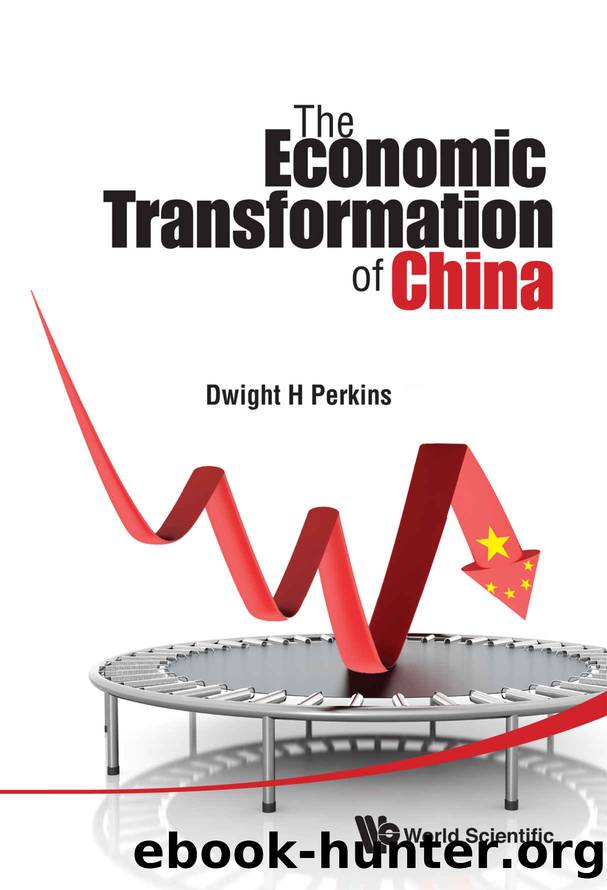The Economic Transformation of China by Dwight H Perkins

Author:Dwight H Perkins
Language: eng
Format: mobi
ISBN: 9789814612395
Publisher: Wspc
Published: 2015-03-26T16:00:00+00:00
Sources: State Statistical Bureau (1985, pp. 36, 413, 420, 450). See also Barry Naughton (1986). Explanation of table:
(1), (3) State enterprise investment includes both âcapital constructionâ and âinvestment in technical updating, transformation.â
(5) These figures are derived as a residual [(7)â(1)â(3)]. The Chinese have published estimates for these categories only for the 1980s.
(7) Total accumulation includes all investment in material-producing sectors including housing minus depreciation.
The issue then becomes one of who determines which clients of the bank receive the funds available and what criteria they use to make these allocations. In China government authorities, both central and local, play a major role in these decisions. Thus, enterprise managers in need of funds must still deal with the government bureaucracy and their allocation criteria. Still, the situation is a far cry from the lax financial policies of the Great Leap Forward (1958â1959) or the system of the 1960s when the banking system existed mainly to monitor the plan and had little authority of any kind to allocate funds. In that period, any enterprise that wanted credit could usually get it if it could show that the proposed uses had some connection with the plan. Enterprises were often awash with credit, but these funds were of limited use because inputs were available only through administrative allocation determined by the plan. The constraint on enterprise behavior, therefore, was the plan, not the enterprise budget.24 Even the shift to greater emphasis on enterprise-retained profits did not necessarily harden the budget constraint as long as the level of taxes payable to the state remained an item for negotiation between the enterprise and the bureaucracy. The state, as mentioned above, is attempting to move to fixed tax rates, which would harden the constraint, but as of 1986 it was still possible for an enterprise in financial difficulty to negotiate a lower rate.
Finally, there is the question of who hires, fires, and promotes enterprise managers. Even with a hard budget constraint, managers may pay special attention to the interests of the planning bureaucracy if they hope someday to be a part of that bureaucracy. If, on the other hand, they care most about their share of profit-based bonuses or the goodwill of their workers who want bonuses and jobs, they will behave more in accordance with the rules of the market. In an effort to reduce this element of bureaucratic control, there is even some talk in China of creating independent boards of directors for enterprises and allowing the boards to select the managers. Little has been done to implement this proposal, however, and it has vigorous opponents (Xu Jingan, 1987; Ma Bin and Hong Junyan, 1987).
Clearly in the mid-1980s, both bureaucratic and market forces governed enterprise behavior. Unfortunately, there is no systematic way to measure the relative strength of these opposing forces with the data now available, but there is indirect evidence. Foreign trade liberalization in 1984â1985, for example, led to a substantial run on foreign exchange reserves and a reintroduction of tight central exchange controls, suggesting that there was considerable excess demand for imports.
Download
This site does not store any files on its server. We only index and link to content provided by other sites. Please contact the content providers to delete copyright contents if any and email us, we'll remove relevant links or contents immediately.
International Integration of the Brazilian Economy by Elias C. Grivoyannis(75373)
The Radium Girls by Kate Moore(11624)
Turbulence by E. J. Noyes(7704)
Nudge - Improving Decisions about Health, Wealth, and Happiness by Thaler Sunstein(7247)
The Black Swan by Nassim Nicholas Taleb(6772)
Rich Dad Poor Dad by Robert T. Kiyosaki(6185)
Pioneering Portfolio Management by David F. Swensen(6083)
Man-made Catastrophes and Risk Information Concealment by Dmitry Chernov & Didier Sornette(5655)
Zero to One by Peter Thiel(5495)
Secrecy World by Jake Bernstein(4390)
Millionaire: The Philanderer, Gambler, and Duelist Who Invented Modern Finance by Janet Gleeson(4105)
The Age of Surveillance Capitalism by Shoshana Zuboff(3990)
Skin in the Game by Nassim Nicholas Taleb(3973)
The Money Culture by Michael Lewis(3850)
Bullshit Jobs by David Graeber(3837)
Skin in the Game: Hidden Asymmetries in Daily Life by Nassim Nicholas Taleb(3730)
The Dhandho Investor by Mohnish Pabrai(3562)
The Wisdom of Finance by Mihir Desai(3528)
Blockchain Basics by Daniel Drescher(3332)
